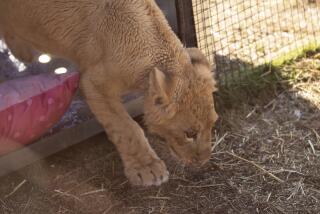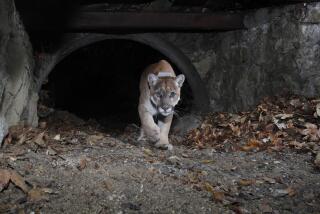Hang out with the lions after dark during a sleepover at London Zoo
Reporting from London — Tea time on a drizzly London afternoon in March. Our taxi pulled up outside the brick walls of the venerable London Zoo in Regent’s Park.
The cabbie noticed we were schlepping suitcases. “But this is a zoo!” he said.
“We know it’s a zoo,” I replied. “We’re here to spend the night with the lions.”
My wife, Sharon, and I had come for a sleepover at the Land of the Lions, an innovative exhibit at the London Zoo that was opened a year ago by Queen Elizabeth.
The Zoological Society of London, which runs the zoo, offers up to 36 visitors a night the chance to experience the world of the Asiatic lion after dark, part of a program to raise awareness about this critically endangered animal.
We entered the expansive Land of the Lions area (more than 26,000 square feet) and strolled past brightly painted storefronts re-creating a market street in Sasan Gir, the village in northwest India adjoining the Asiatic lions’ habitat.
This subspecies of big cat, renowned as the biblical lion of Judah, once ranged from Greece to India. The Asiatic lion is now endangered; India’s Gir Forest its last habitat in the wild.
As we strolled through a faux temple clearing, we passed exhibits of mongooses, peacocks and langur monkeys — all, like the lions, native to the Gir Forest.
For me this was a kind of homecoming.
More than 30 years ago, accompanied by Sharon and a camera crew, I was in the Gir Forest directing a National Geographic TV documentary about Asiatic lions.
Despite the 100-degree heat and some harrowing moments, the two-month adventure was an experience I cherish.
I never imagined it was one I could relive.
And yet, here I was, in London of all places, doing just that.
At 4:30 p.m., check-in time, Joy, our Gir Lion Lodge host, escorted us to one of the nine guest lodges. My mind flashed back to our stay in the austere Gir Forest guesthouse in India long ago, with its stifling mosquito netting, squeaky ceiling fan and malodorous toilet.
Here I found a bed with crisp white linens, a colorful wall mural and a shiny new bathroom with heated towel racks.
It was dusk by the time we joined the dozen other overnight guests — all Brits — for a glass of Prosecco in a mock-up of a Sasan Gir villager’s dwelling.
We gazed through the windows facing the rugged terrain of the lion enclosure, where I spotted the male Asiatic lion, Bhanu (Hindi for “the sun”).
Like other males of his subspecies, he had a less bushy mane than an African lion and a fold of skin running along his belly that his African cousins lack.
Bhanu lounged just beyond the observation window on a heated slab, a “creature comfort” placed there to permit viewing at unnervingly close range.
The lions sleep up to 20 hours a day but come to life after dark, when regular zoo visitors have left. Our host handed out flashlights and infrared scopes for a rare chance to observe the big cats at night.
We watched the male prowl over to the three females, sisters ranging in age from 4 to 6.
The females yawned and stretched as they woke up from a nap. Bhanu sniffed them, grunting. They rebuffed his advances this time, but the zoo hopes that soon nature will take its course and they will bear cubs.
Continuing our after-hours tour, our guides led us to see other animals that become active at night. We fed handfuls of hay to pygmy hippos and visited playful otters and a colony of endangered fruit bats.
Then it was feeding time at the zoo — for us.
In the zoo restaurant, decorated with festive Indian cloth and umbrellas, our buffet dinner included chicken Provencal and grilled squash with chickpeas — a far cry from the daily diet of stewed goat we had subsisted on years ago in the Gir Forest.
After chocolate brownies, we set out to complete our tour of the zoo by night.
My favorite creatures were the South African aardvarks with their pig snouts, rabbit ears and insanely long tongues. Our guides encouraged us to toss them treats of crickets and mealworms, which they gobbled up.
Later that night, snug in our lodge, I lay in bed and listened to the roar of the nearby lions. It jolted me back more than 30 years to the day I was directing the crew filming lions in the Gir: As I moved through the brush toward the cameraman, I hadn’t realized I was being stalked by a young lion.
Suddenly, I heard shouts. The park rangers waved their shotguns and threw stones, scaring it away.
On this night, half a lifetime later, I savored the memory of my close call as I drifted off.
The staff roused us at 7:30 a.m. for a hearty English breakfast. Then, taking advantage of the peaceful hour before the zoo opened, we savored an exclusive performance by frolicking penguins, playful Sumatran tigers, a Komodo dragon and a Galápagos tortoise that didn’t look a day over 100.
At 10 a.m, when the zoo gates opened to the public, we thanked our hosts and hailed a taxi. We drove past the regal bronze lions of Trafalgar Square, which seemed to eye us approvingly.
Though the Asiatic lion is endangered, I found hope that instead of the 200 or so alive during my visit long ago, India’s Gir Forest today has more than 500.
Our overnight stay at the London Zoo sweetly evoked my youthful adventure and whetted my appetite to revisit these tenacious creatures in their natural home. I took comfort that the Asiatic lion still roars, and that in his Gir Forest kingdom — and in the London Zoo — he still rules.
If you go
THE BEST WAY TO LONDON
From LAX, American, British, Air New Zealand, Virgin Atlantic, United and Norwegian offer nonstop service to London, and KLM, American, United, Air Canada and Delta offer connecting service (change of planes). Restricted round-trip fares from $781, including taxes and fees.
The Gir Lion Lodge Experience at the London Zoo takes place six nights a week from February to December, offering family-friendly and adults-only nights.
Each of the nine lodges accommodates two adults and two children. Prices from about $570 per lodge ($285 per person) include after-hours guided tours of the zoo, buffet dinner and English breakfast.
Closer to home, the Los Angeles Zoo Creature Camp Out includes a tent in base camp, guided tour, animal encounter, bedtime story and continental breakfast for $85 per person. The San Diego Zoo Safari Park in Escondido has Roar & Snore Experiences for families and adults. From $140 per person, not including admission.
»
»
More to Read
Sign up for The Wild
We’ll help you find the best places to hike, bike and run, as well as the perfect silent spots for meditation and yoga.
You may occasionally receive promotional content from the Los Angeles Times.






